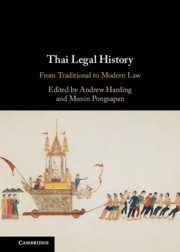Book contents
- Thai Legal History
- Additional material
- Thai Legal History
- Copyright page
- Contents
- Tables
- Contributors
- Preface
- Chronology
- Table of Cases
- Legislation, Constitutional Provisions, and Treaties
- Abbreviations
- 1 Introduction
- 2 Thai Legal History
- Part I Traditional Law and its Modern Resonances
- 3 Thammasat, Custom, and Royal Authority in Siam’s Legal History
- 4 The History of the Initial Royal Command
- 5 Buddhist Influence on the Ancient Siamese Legal System, from Ayutthaya to the Twenty-First Century
- 6 A History of the Thai Lèse-Majesté Law
- 7 Blood Curse and Belonging in Thailand
- Part II Foreign Influence and the Reform Period
- Part III Constitutional Conflicts 1932–2017
- Glossary
- Index
3 - Thammasat, Custom, and Royal Authority in Siam’s Legal History
from Part I - Traditional Law and its Modern Resonances
Published online by Cambridge University Press: 28 May 2021
- Thai Legal History
- Additional material
- Thai Legal History
- Copyright page
- Contents
- Tables
- Contributors
- Preface
- Chronology
- Table of Cases
- Legislation, Constitutional Provisions, and Treaties
- Abbreviations
- 1 Introduction
- 2 Thai Legal History
- Part I Traditional Law and its Modern Resonances
- 3 Thammasat, Custom, and Royal Authority in Siam’s Legal History
- 4 The History of the Initial Royal Command
- 5 Buddhist Influence on the Ancient Siamese Legal System, from Ayutthaya to the Twenty-First Century
- 6 A History of the Thai Lèse-Majesté Law
- 7 Blood Curse and Belonging in Thailand
- Part II Foreign Influence and the Reform Period
- Part III Constitutional Conflicts 1932–2017
- Glossary
- Index
Summary
Robert Lingat argued that in Siam’s traditional legal system, based on an Indian model, law was based on custom and morality, encoded in texts descended from the Indian dharmasastra, and the king was primarily an enforcer and could legislate only within these codes. In the mid-20th century, Prince Dhani Nivat adopted this argument in his construction of a theory of moral kingship for the ninth reign. The argument thus became sacrosanct. However, there is little evidence of dharmasastra-thammasat in Siam—only one ambiguous reference in 500 years of history and no text found, compared to hundreds in Myanmar. Meanwhile there is strong evidence of royal law-making back to at least the 15th century. Laws were made by royal decree or by court judgements handed down by the king or his deputy. Law codes were compiled and preserved by royal scribes, and enforced in a system of courts with the monarch at its apex. The Thammasat that heads the Three Seals Law (the collection of old laws assembled in 1805) is very different from those in Myanmar and elsewhere. The first part appears to be copied from a Myanmar source, but the codification of customary and moral principles, which forms 90 percent of the Myanmar texts, is completely missing. Instead the latter part of Thai Thammasat is an index to the whole Three Seals Law. This must have been compiled in a relatively late recension of the whole code, probably in the late 17th or 18th century. Appreciating the royal role in law-making offers a better understanding of the late Ayutthaya state, and a different perspective on Siam’s legal tradition.
Keywords
- Type
- Chapter
- Information
- Thai Legal HistoryFrom Traditional to Modern Law, pp. 23 - 40Publisher: Cambridge University PressPrint publication year: 2021
- 1
- Cited by

